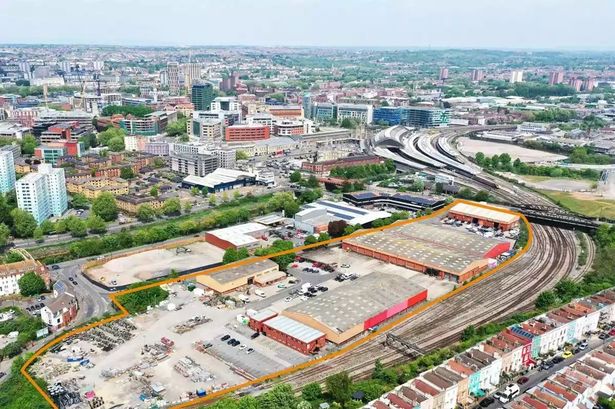
“Everything has just stopped”
The land at Mead Street outlined in orange, which was sold by estate agents Cushman & Wakefield(Image: Cushman & Wakefield)
The mission to solve Bristol’s housing crisis by building blocks of flats on ‘brownfield’ industrial sites in inner city Bristol is experiencing a ‘perfect storm’ that is delaying or scrapping developments, Bristol Live can reveal. With so many projects stuck in limbo, It could be four years before the next major residential development is finished, one industry expert in the city has warned.
The issue is so bad that plans to redevelop one key industrial area of the city – where Bristol City Council had drawn up a ‘masterplan’ to create almost a thousand new homes – appear to have been scuppered for years, after it was Temple Quarter regeneration projectwho wants to keep it as an industrial area rather than build new homes there.
The sale of a vast area which was marketed as ‘Temple Gate’ – to a industrial buyer rather than a residential property developer – has sent shockwaves through Bristol’s development industry and at City Hall. The land, on the south side of Mead Street, between Temple Meads and Totterdown, was the subject of the ‘Mead Street masterplan’.
This was drawn up by Bristol City Council, with a vision to turn the collection of industrial units and sites behind the Fowlers motorcycle dealer into a new suburb of Bristol with more than 900 new homes in tower blocks up to 22 storeys high. When it was put for sale as a development opportunity, the land was instead sold to a property investment company who will refurbish and keep the existing industrial units rather than clear the site and build the hundreds of new homes proposed by the council.
Despite council backing and encouragement to begin the transformation of the Mead Street land as part of the vastRedcliffe Quarter, several housing developers found themselves outbid by that industrial property investment company.
A property investment firm was prepared to pay more for the large amount of land to remain as industrial units than a property developer was prepared to pay, because the spiralling costs of building new homes on brownfield sites meant those developers were not prepared to risk as much for the land upfront.
It means the council’s big vision for the Mead Street Regeneration won’t now be happening for years – if ever. The plans for 900 new homes were first put forward by the previous Labour administration under former Mayor Marvin Rees, and formed a key part of the proposed transformation of the area around Temple Meads station.
READ MORE: ‘Significant’ development land for sale in Bristol city centreREAD MORE: ‘Details needed’ on height of 1,500 new homes in front of famous view of Totterdown
Back in 2022, the idea sparked controversy and a campaign to ‘save’ the view of the famous coloured houses on the stop of the Totterdown escarpment, but now the land behind Fowler’s looks set to remain as it is for years to come.
The man in charge of the sale was Nick Allan, from the Bristol office of one of the world’s leading real estate services firms, Cushman & Wakefield. “We had interest from the industrial investors market, as well as from the residential developers market, and the most compelling proposal for our clients was from an industrial investor who will be keeping the site as industrial,” he said.
“Had we been selling it 18 months or even 12 months ago, it’s likely it would have been a residential developer who bought it. But things are slowing down significantly,” he said.
Illustrations of the 900 apartment development at Mead Street, in front of Totterdown, proposed in 2022(Image: Marina Samvelyan)
Mr Allan said that, even though demand for new homes and student accommodation, rents and sales of new flats was still as strong as ever, the costs of building those new flats was now rising higher than property developers could afford to go.
“There’s essentially a perfect storm happening right now for people who take brownfield sites and turn them into residential development. That’s not just a Bristol thing, it’s happening all over the country. The one thing Bristol has in its favour is that the sales or retail value is stronger here, which means we should be able to drive better viability, but conversely Bristol is known as quite an expensive place to build,” he added.
The ‘perfect storm’ is a combination of the increased costs of physically building new flats, but even more – the increase in new regulation around building taller residential buildings, and lengthy delays in implementing those new regulations.
The new Building Safety Act became law in 2022 but in the past year many of its new regulations have come into force. Anyone creating a residential building more than 18 metres tall now has to include two staircases and fire access lifts to meet stringent new fire regulations in the wake of the Grenfell Tower tragedy.
READ MORE: Communal areas removed to fit more rooms into Bristol’s first major ‘Co-living’ tower blockREAD MORE: Plans on hold to fit more rooms in 18-storey co-living block as councillors brand them ‘recipe for disaster’
On top of that, developers have to pass through a huge amount of regulation and the requirements of the Building Safety Regulator, both before and after they receive planning permission, before any work can actually take place.
It is supposed to take around 12 weeks for the Building Safety Regulator to sign off on a developer’s plans for a new block of flats, but since last year, that has been taking more than 12 months in many cases.
The logjam is so huge that last month the House of Lords opened an inquiry into Building Safety Regulator delays. Leading figures in the construction industry said developers were planning to take legal action against the Government for the delays, and the Government itself – just three weeks ago – announced a ‘new fast track process to unblock delays’.
The impact of this means that it is far more expensive to build blocks of flats than it was just a year ago. “Developers are now looking at having to spend £1 million on a scheme to get planning permission, and another £1 million after they get planning permission before they can even start work,” said Mr Allan. “That’s not an insignificant amount. It means the viability of many schemes is in doubt.
An artists impression of new student accommodation on Albert Road in Bristol(Image: Cubex)
“There are so many around Bristol that have planning permission but nothing has happened, they are either stuck with the delays or are looking at rising costs, so developers are looking again at the viability,” he added.
Across the road from the Mead Street land is another former factory that is earmarked for housing. The old Bart Spices factory has long since been demolished – the business moved to Avonmouth – but three years after getting planning permission, Donard Homes still haven’t started work and are back at City Hall on Monday asking for permission to cut the number of affordable homes because the Building Safety Act now means they need to install more staircases.
And down the river at Baltic Wharf, the council’s own housing company Goram Homes are also in Monday’s City Hall planning meeting, asking councillors for permission to change the way the affordable housing provision on their scheme is funded, because otherwise the development would not be financially viable.
READ MORE: Baltic Wharf affordable housing doubts as developer says it needs government to payREAD MORE: Affordable homes to be cut in Bristol riverside flats plan
“At the moment, the only development that is nearing completion is the big demolish the Premier Inn one,” said Mr Allan. “After that, I can’t think of any others that are going to be finished soon. Everything else has just stopped. Given it’s taking a year or more to go through planning and the regulations, and it takes two or three years to build anything, it could be four years before we see the next major development in Bristol completed,” he predicted.
Work to demolish the Premier Inn at the Bearpit is nearly completed, with a long timescale to then construct a major block of student accommodation and ‘co-living’ development in its place, yet to get underway – after a row over plans to change the internal design to cope with the new fire regulations.
But after that, development proposals for other city centre sites – at The Galleries, the Rupert Street NCP car park, the former Debenhams site, the former Peugeot dealer site opposite Temple Meads station, and the redevelopment of another multi-storey car park site in The Pithay into student flats – are yet to see work on the ground.
Revised plans for 221 flats on the corner of York Road and St Luke’s Road in Bedminster(Image: Donard Homes)
One Bristol industry expert told Bristol Live developers and the city council were caught ‘in an impossible situation’.
“It’s not the council’s fault – these are national factors and issues,” he said. “The council are rightly insisting that affordable homes are included but when a developer has to cut costs, that’s one of the places they can save. Without doing that, they are telling the council the entire scheme won’t be possible.
“It’s getting to the point now that even if the affordable housing element is cut back, developers are still looking at it and asking if it is viable. If you have to include two stairways and access lifts and so on, that’s a bigger part of the area of the building that isn’t bringing in any money in sales or rents.
“So that makes it a bigger risk, it needs a lot of money invested up front, and the cost of borrowing is high at the moment. So these investment firms are thinking ‘well we could put this money into Government bonds and essentially earn 4.5 per cent over ten years for free’, or they could risk that money building new homes in Bristol which might not make any money at all,” he added.
In a statement on June 30, the Minister for Building Safety addressed the delays faced by builders of high-rise homes. Alex Norris said: “The establishment of the Building Safety Regulator has been fundamental to centralising safety in the construction process and it’s time to take the next steps to build on that precedent and create a system that works for the sector whilst keeping residents and their safety at the heart of the process.
“That’s why we’re announcing a package of reforms to the Building Safety Regulator to enhance operations, reduce delays, and unlock the homes this country desperately needs – delivering on our Plan for Change.”





